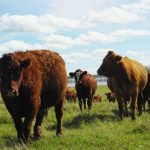Livestock research needs to benefit producers and tell the public a positive story about animal agriculture.
If research can show benefits like enhanced food safety or environmental protection from improved practices on the farm, the urban public may be more supportive of the beef industry, said Reynold Bergen, director of the Beef Cattle Research Council.
“The message we need to get out is that cattle are making a positive contribution both in terms of the carbon sequestration that forages do and maintaining the water cycle,” he told the annual meeting of the Alberta Beef Producers, which was held Dec. 6-8 in Calgary.
Read Also

European wheat production makes big recovery
EU crop prospects are vastly improved, which could mean fewer canola and durum imports from Canada.
“It is important our legislators have real sound science that they can use to form their policy and balance the emotional argument that is coming from the other side,” he said.
For example, one project overseen by the Public Health Agency of Canada is looking at the use of antimicrobials in livestock feed to see if there is a link to the increasing problem of antibiotic resistance in human medicine.
This kind of project has been run three times and so far no link to human health has been found.
“What we are finding is that there is absolutely no evidence that the beef industry is contributing to this,” he said. “On the regulatory side, it shows industry is using this stuff responsibly.”
In the area of livestock transportation, the public sees animals being moved in trucks and questions how they are treated. Yet studies starting in 2006 show livestock are not being abused or suffering in transit.
“It is really important that we have numbers that we can back up to counter these arguments,” he said.
However, producers often complain they are paying for research but do not see enough return on their investment because the information never flows back to them.
“It is a common complaint that we fund research and it just stays on the shelf,” Bergen said.
The council publishes updates on its projects on the Canadian Cattlemen’s Association website and works with other organizations like farm animal care groups to distribute information in newsletters.
Camrose rancher Dave Solverson said a lot of the research is defending industry practices like transportation and medication use. Perhaps more money is needed to support research that goes beyond those issues in the future.
“It is unfortunate research money can’t be used for improving the industry rather than collecting data proving what we are doing is sustainable,” he said.
Farmer run commodity groups have been forced to contribute a larger share of their own money to research as extension services dry up and deficit haunted governments pull back on publicly funded research.
For the 2010 fiscal year, the research council had about $1.1 million in revenue.
A large share of the money came through a $1 national levy from beef producers in each province. It almost lost about half that money this year in a dispute in Alberta as to whether that dollar should be included as part of the refundable checkoff. At the end of November, Alberta agreed to send its share and make only $2 of its $3 checkoff refundable.
“Predictable funding is critical for any sort of effective research and every dime counts,” Bergen said.
Most of the provinces contribute five cents of every dollar for research while Alberta and Saskatchewan designate 10 cents each.
Formed in 1997, the council has leveraged $20 million for projects. For every dollar the council puts up, the federal and provincial governments contribute $5.
In 2008, the beef science cluster was created as a partnership between the beef industry and Agriculture Canada to fund research for beef industry competitiveness.
















